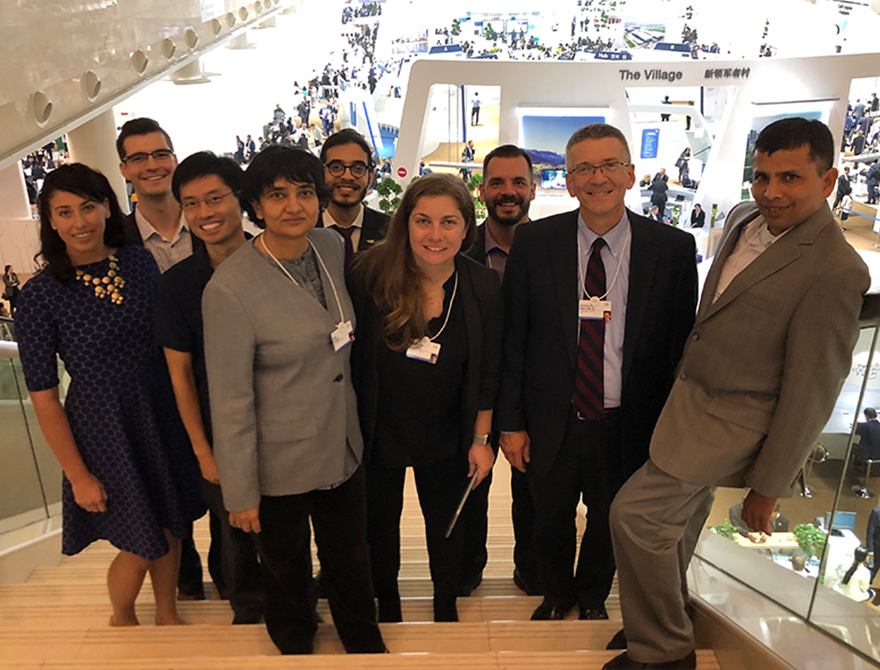CMU sends delegation to “Summer Davos”
CMU sent a delegation of faculty, students, and alumni led by College of Engineering Dean James H. Garrett to the World Economic Forum's Annual Meeting of New Champions.
Carnegie Mellon University sent a delegation of faculty, students and alumni led by College of Engineering Dean James H. Garrett to the World Economic Forum's Annual Meeting of New Champions, Sept. 18-20 in Tianjin, China. The meeting, which carries the theme“Shaping Innovative Societies in the Fourth Industrial Revolution," is discussing the essential elements required for creating the innovative societies of the future. Several of the delegation members are presenting at the meeting.
“I am very proud of all the great work of my CMU colleagues from across the university being showcased here at the World Economic Forum event here in Tianjin,” said Garrett, who attended on behalf of the president's office and represented CMU as a member of the Global University Leaders Forum (GULF). CMU is one of only 28 universities in the world, 12 in the U.S., that make up the GULF community, which provides a unique platform for the world’s top universities to discuss higher education and research while helping to shape the World Economic Forum agenda. GULF fosters discussion on global policy issues between member universities, the business community and a broad range of stakeholders.
CMU experts have led global conversations at the World Economic Forum, in fields ranging from robotics to artificial intelligence since 2011. The World Economic Forum is a not-for-profit foundation committed to improving the state of the world. The forum brings together business, government, academic and civil society leaders from around the world to help shape global, regional and industry agendas.
I am very proud of all the great work of my CMU colleagues being showcased here at the World Economic Forum event.
James H. Garrett, Jr., Dean, College of Engineering, Carnegie Mellon University
Among the needs are expanding the reach for education through technology. The population of the global south is expanding rapidly, and very soon, the majority of the world learners will be in located in Africa. Amy Ogan, assistant professor in CMU’s Human-Computer Interaction Institute, is among the panelists discussing how to educate these innovative societies. She also is among the Class of 2018 Young Scientists Community in Tianjin.
“One of my research goals is creation of an equitable education around the world,” Ogan said. Her work is aimed to create societies prepared to create innovations of the 21st century to solve major problems.
Rita Singh, an associate research professor in the Machine Learning for Signal Processing Group in the School of Computer Science’s Language Technologies Institute, is demonstrating her voice technology research. Participants can interact with the technology and information about them will be revealed, all garnered from their voice.

Source: Carnegie Mellon University
Members of the CMU delegation at the World Economic Forum’s Tianjin
One of this year’s Featured Artists is Madeline Gannon, head of ATONATON, a research studio inventing better ways to communicate with machines. Her installation, Manus, is a set of 10 industrial robots which display animalistic behaviors. Guests are encouraged to interact with the exhibit, which uses 12 depth cameras to detect and track body language. Gannon earned her Ph.D. in computational design and architecture from CMU’s School of Architecture in 2017.
Po-Shen Loh, associate professor of mathematical sciences, is among the Class of 2018 Young Scientists Community in Tianjin. Loh’s research in advancing core theory in mathematics is working to deliver practical solutions, such as smartphone learning systems. This work is evident in his company, Expii. Loh also serves as head coach of the U.S. International Mathematical Olympiad team, which took first place in Cluj-Napoca, Romania this summer. This is the United States’ third world mathematics title in the last four years under Loh.
Gabriel O’Donnell, principal research programmer at the CMU CREATE Lab, led a discussion titled "The Big Picture on Cyber-Resilience" where through NASA time-lapse satellite imagery and geospatial and econometric data, he explored the causes and consequences of cyberattacks now and through time.
